Click any hole number below for information, yardages, hole schematics, and historical significance.
-
Hole #1 | Par 4 | HDCP 8
REPLICA OF THE COUNTRY CLUB #17
MAJOR CHAMPIONSHIPS HOSTED: U.S. OPEN – 1913, 1963, 1988Gold 379 • Blue 370 • White 361 • Red 313
 Historical Significance
Historical SignificanceFrancis Ouimet was a 20-year-old former caddie when he birdied the 17th during the final round of the 1913 U.S. Open to force a playoff with British immortals Ted Ray and Harry Vardon. Ouimet’s victory the next day established him as America’s first golfing hero.
Fifty years later, during the final round of the U.S.Open, Arnold Palmer three-putted the 17th for bogey and Jackie Cupit took double-bogey, each losing a chance to win outright. Instead, Julius Boros beat both of them in a playoff. More recently, Justin Leonard rammed home a dramatic 40-foot birdie putt at the 17th to claim the 1999 Ryder Cup for the U.S. team, setting off a spirited and controversial celebration by the Americans.
Renditions has not received permission to copy the selected hole and is not associated with, affiliated with or sponsored by the golf courses, champions, or championships listed here.
-
Hole #2 | Par 3 | HDCP 14
REPLICA OF INVERNESS CLUB #12
MAJOR CHAMPIONSHIPS HOSTED: U.S. OPEN – 1920, 1931, 1957, 1979 • PGA – 1986Gold 167 • Blue 149 • White 137 • Red 117
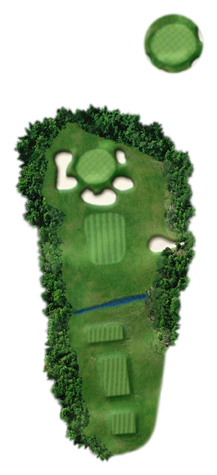 Historical Significance
Historical SignificanceThree of golf’s five career Grand Slam Champions played their first U.S. Open at Inverness Club in Toledo, Ohio. Bobby Jones and Gene Sarazen were each 18 years old when they competed in the 1920 U.S. Open, the same age Jack Nicklaus was in his 1957 debut.
In 1979, 19-year-old Bobby Clampett missed the cut after earning low-amateur honors the year before. Playing as a “marker” on the weekend, he proceeded to amuse the gallery by hitting shots from his knees and plumb-bobbing from bunkers. On the 12th tee, a USGA official asked him to leave, earning him the unique distinction of being cut twice from the same U.S. Open.
Renditions has not received permission to copy the selected hole and is not associated with, affiliated with or sponsored by the golf courses, champions, or championships listed here.
-
Hole #3 | Par 4 | HDCP 12
REPLICA OF SOUTHERN HILLS #17
MAJOR CHAMPIONSHIPS HOSTED: U.S. OPEN – 1958, 1977, 2001 • PGA – 1970, 1982, 1994Gold 334 • Blue 325 • White 306 • Red 284
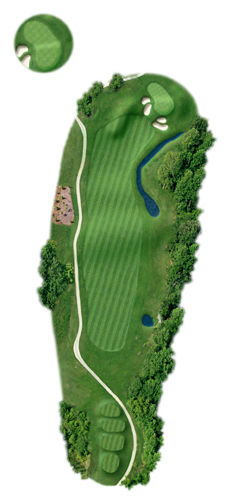 Historical Significance
Historical SignificanceNoted course architect Perry Maxwell designed Southern Hills Country Club in Tulsa, Oklahoma. Opened in 1935, the course was redesigned by Robert Trent Jones prior to the 1958 Open, which was won by the flamboyant Tommy “Thunder” Bolt.
During the third round of the 1977 Open, an anonymous caller told the FBI that three men planned to kill leader Hubert Green on the 15th hole on Sunday. The threat was not relayed to Green until Sunday as he finished the 14th. Given the opportunity to suspend play, Green instead elected to continue. He got down in two from 50 feet at the 17th and made a “gut-stringer” four footer at 18 to win by one.
Renditions has not received permission to copy the selected hole and is not associated with, affiliated with or sponsored by the golf courses, champions, or championships listed here.
-
Hole #4 | Par 4 | HDCP 18
REPLICA OF ROYAL LYTHAM & ST. ANNES #16
HOST TO THE BRITISH OPEN: 1926, 1952, 1958, 1963, 1969, 1974, 1979, 1988, 1996, 2001Gold 357 • Blue 340 • White 324 • Red 291
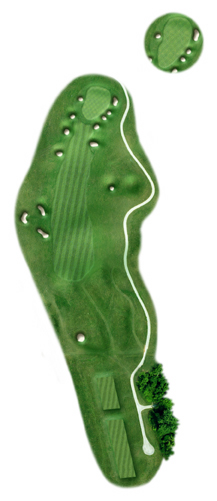 Historical Significance
Historical SignificanceBobby Jones won his first of three British Open Championships at Royal Lytham & St. Annes in 1926. No American would be victorious in The Open at Lytham again until Tom Lehman (1996) and David Duval (2001) each earned their first major.
The 16th is the site of glory for Seve Ballesteros. In 1979, at the age of 22, Seve hit one of his trademark wild drives, with the ball coming to rest under a parked car near a hospitality tent, some forty yards right of the fairway. Receiving his free drop, Seve hit his approach to within 20 feet and made the putt for birdie. In 1988, his 1-iron at #16 split the fairway, followed by a 9-iron to within three inches, leading to a victorious final round score of 65.
Renditions has not received permission to copy the selected hole and is not associated with, affiliated with or sponsored by the golf courses, champions, or championships listed here.
-
Hole #5 | Par 5 | HDCP 16
REPLICA OF ROYAL BIRKDALE #15
HOST TO THE BRITISH OPEN: 1954, 1961, 1965, 1971, 1976, 1983, 1991, 1998Gold 543 • Blue 509 • White 499 • Red 475
 Historical Significance
Historical SignificanceTwo of The Open Championship’s five-time winners, Peter Thompson and Tom Watson, captured their fifth title at Royal Birkdale. They joined J.H. Taylor and James Braid as an elite group one title shy of Harry Vardon, who amassed six between 1896 and 1914.
Arnold Palmer won his first of consecutive British Opens at Royal Birkdale in 1961, after finishing second by one stroke at St. Andrews the previous year. His appearance at The Open breathed new life into the beleaguered championship and defined the modern day Grand Slam.
In 1998, Mark O’Meara birdied the 15th, the first hole of a four-hole playoff, and went on to capture the Claret Jug and his second major championship of the year.
Renditions has not received permission to copy the selected hole and is not associated with, affiliated with or sponsored by the golf courses, champions, or championships listed here.
-
Hole #6 | Par 4 | HDCP 4
REPLICA OF AUGUSTA NATIONAL #11
HOST TO THE MASTERS: 1934 – 1942, 1946+Gold 455 • Blue 442 • White 380 • Red 370
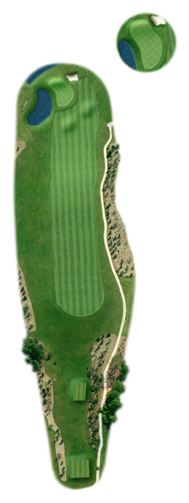 Historical Significance
Historical SignificanceAfter completing his Grand Slam in 1930, Bobby Jones retired from tournament golf at the age of 28. In 1933, he opened Augusta National Golf Club, built on a former nursery that Jones and investors purchased for $70,000. 1934 marked the first “Invitation Tournament”, soon to be known as “The Masters.”
The 11th hole features one of the most-feared second shots in golf and marks the beginning of “Amen Corner.” Nick Faldo won consecutive titles in 1989-90, each in sudden death at the 11th. In the 1987 playoff, Larry Mize hit one of the most famous shots in all of major championship golf when he chipped in for birdie from 140 feet to the right of the hole, dealing Greg Norman another stunning defeat.
Renditions has not received permission to copy the selected hole and is not associated with, affiliated with or sponsored by the golf courses, champions, or championships listed here.
-
Hole #7 | Par 3 | HDCP 6
REPLICA OF AUGUSTA NATIONAL #12
HOST TO THE MASTERS: 1934 – 1942, 1946+Gold 155 • Blue 145 • White 135 • Red 120
 Historical Significance
Historical SignificanceGary Player called the 12th hole at Augusta National “the toughest par three in the world.” Jack Nicklaus said it is “the toughest tournament hole in golf.” Swirling winds and a narrow green make club selection difficult. During the first round in 1980, Tom Weiskopf deposited five balls in Rae’s Creek, taking a 13.
The next day, he put in two more balls and made a 7. Only 1948 champion Claude Harmon, Bill Hyndman, and Curtis Strange have aced the 12th in Masters’ play. Claude Harmon made his ace in 1947 while paired with Ben Hogan. Without any reaction, Hogan hit his shot on the green and made his birdie putt. Walking to the next tee, Hogan finally said, – You know, Claude, that’s the first 2 I’ve ever made on that hole.
Renditions has not received permission to copy the selected hole and is not associated with, affiliated with or sponsored by the golf courses, champions, or championships listed here.
-
Hole #8 | Par 5 | HDCP 10
REPLICA OF AUGUSTA NATIONAL #13
HOST TO THE MASTERS: 1934 – 1942, 1946+Gold 485 • Blue 465 • White 455 • Red 408
 Historical Significance
Historical SignificanceOne of the most beautiful holes in all of golf, the 13th at Augusta National has marked the turning point in many Masters championships. A relatively short par 5, players can make up strokes by going for the well-protected green in two. In 1937, Byron Nelson followed his birdie at the 12th by sinking a fifty-foot eagle chip at 13, making up six strokes in two holes and earning for him the first of his two green jackets.
In the last two rounds of 2001, Tiger Woods followed a bogey at 12 with a birdie at 13, helping to secure his victory. Others have not been so fortunate. Billy Joe Patton, Curtis Strange, Fred Couples and others have watched their approach shots and their title hopes disappear into the fronting creek, just a few feet short of glory.
Renditions has not received permission to copy the selected hole and is not associated with, affiliated with or sponsored by the golf courses, champions, or championships listed here.
-
Hole #9 | Par 4 | HDCP 2
REPLICA OF OAKLAND HILLS #16
MAJOR CHAMPIONSHIPS HOSTED: U.S. OPEN – 1924, ’37, ’51, ’61, ’85, ’96 • PGA – 1972, 1979, 2008Gold 406 • Blue 401 • White 377 • Red 312
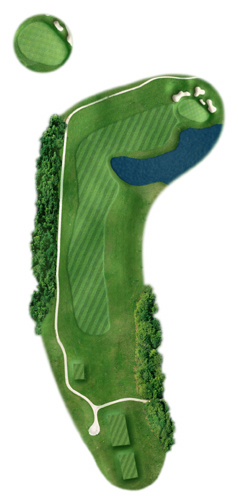 Historical Significance
Historical SignificanceDesigned by Donald Ross, Oakland Hills in Birmingham, Michigan has played host to more U.S. Opens than all but two courses. Redesigned for the 1951 Open, the course was unforgiving. Ben Hogan won with an incredible closing round of 67, afterwards dubbing the course “The Monster.”
In the 1972 PGA, Gary Player came to the 16th on the final day tied for the lead. His sliced tee shot landed behind a large willow tree, just short of the pond. Needing loft, he chose a 9-iron for the 150-yard shot and swung with all of his might. The ball barely cleared the tree and came to rest four feet from the cup. Player made his birdie and, two holes later, won his second PGA Championship.
Renditions has not received permission to copy the selected hole and is not associated with, affiliated with or sponsored by the golf courses, champions, or championships listed here.
-
Hole #10 | Par 4 | HDCP 1
REPLICA OF MEDINAH (No. 3) #6
MAJOR CHAMPIONSHIPS HOSTED: U.S. OPEN – 1949, 1975, 1990 • PGA – 1999, 2006Gold 449 • Blue 434 • White 422 • Red 381
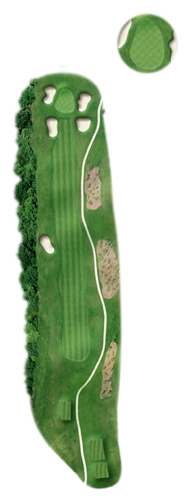 Historical Significance
Historical SignificanceLocated just outside of Chicago, Medinah Country Club was developed in the 1920’s by The Shriners. At the U.S. Open in 1990, two-time winner Hale Irwin received a special exemption, allowing him to play without qualifying. Irwin’s 50-foot birdie putt on the final hole in regulation was followed by a memorable sprint around the green, where he high-fived the gallery. He captured his third U.S. Open in a playoff the next day.
In the third round of the 1999 PGA Championship, Tiger Woods’ second shot at the 6th came up a few yards short. Putting with a 3-wood, Tiger made the 50-footer for birdie and went on to a one-stroke victory and his second major championship.
Renditions has not received permission to copy the selected hole and is not associated with, affiliated with or sponsored by the golf courses, champions, or championships listed here.
-
Hole #11 | Par 4 | HDCP 13
REPLICA OF OAK HILL #17
MAJOR CHAMPIONSHIPS HOSTED: U.S. OPEN – 1956, 1968, 1989 • PGA – 1980, 2003Gold 458 • Blue 452 • White 397 • Red 383
 Historical Significance
Historical SignificanceOak Hill in Pittsford, New York, boasts of “Heartbreak Bend”, perhaps the most difficult closing three holes in golf. The long 17th was the hardest hole at the 1989 U.S. Open. In the 1956 Open won by Cary Middlecoff, Ben Hogan missed a two-footer at the 17th that would have clinched a tie and possibly a record fifth title.
At Oak Hill in 1968, Lee Trevino became the first player in U.S. Open history to post four rounds in the 60s. Jack Nicklaus beat the field by a still-record seven shots when he stormed to his fifth PGA Championship in 1980. In 1989, Curtis Strange’s patience carried him to the first back-to-back U.S. Open victories since Ben Hogan in 1951.
Renditions has not received permission to copy the selected hole and is not associated with, affiliated with or sponsored by the golf courses, champions, or championships listed here.
-
Hole #12 | Par 5 | HDCP 17
REPLICA OF CARNOUSTIE #6
HOST TO THE BRITISH OPEN: 1931, 1937, 1953, 1968, 1975, 1999Gold 541 • Blue 520 • White 458 • Red 440
 Historical Significance
Historical SignificanceThe 6th at Carnoustie, Scotland is listed as one of the “Top 18 Holes in the World.” Following victories at the Masters and U.S. Open in 1953, Ben Hogan ventured to Carnoustie for his only British Open appearance. In each of the final two rounds, his drives at the 6th took a precarious route between the fence and the bunkers, an area now known as “Hogan’s Alley.” He followed each drive with a 4-wood to the green and a two-putt birdie and won by four strokes. Hogan received a ticker-tape parade upon his return.
In the final round of the 1968 Open, Jack Nicklaus hooked his drive at the 6th out of bounds. He lost to Gary Player by two strokes and, years later, when asked where he would use one “mulligan” in his career, chose his ill-fated tee shot at the 6th.
Renditions has not received permission to copy the selected hole and is not associated with, affiliated with or sponsored by the golf courses, champions, or championships listed here
-
Hole #13 | Par 3 | HDCP 11
REPLICA OF TPC SAWGRASS #17
HOST TO THE PLAYERS CHAMPIONSHIP: 1982+Gold 132 • Blue 121 • White 97 • Red 80
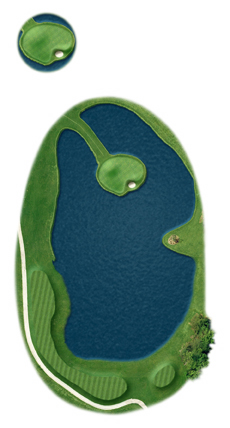 Historical Significance
Historical SignificancePerhaps no other shot in golf is as fearful as the short tee shot at the 17th hole at the Tournament Players Club at Sawgrass, in Ponte Vedra Beach, Florida. Designed by Pete Dye and owned by the PGA Tour, it was the first in a series of TPC courses and, since 1982, has been the permanent site of The Players Championship, also known as golf’s “fifth major.”
In the first round of the 1984 championship, windy conditions led to a one-day stroke average of 3.79, at the time the highest ever for a par 3 on the PGA Tour. Sixty four golf balls found the water that day, leading John Mahaffey to describe the 17th as -one of the easiest par fives on the course. The 17th is one of the -Top 18 Holes in the World.
Renditions has not received permission to copy the selected hole and is not associated with, affiliated with or sponsored by the golf courses, champions, or championships listed here.
-
Hole #14 | Par 4 | HDCP 5
REPLICA OF MERION #11
MAJOR CHAMPIONSHIPS HOSTED: U.S. OPEN – 1934, 1950, 1971, 1981Gold 369 • Blue 349 • White 330 • Red 300
 Historical Significance
Historical SignificanceMerion Golf Club in Pennsylvania is the site of Bobby Jones’ first and last national championship appearances. By 1930, Jones was the world’s greatest golfer and the most popular athlete in America. He had already won that year’s British Amateur, British Open and U.S. Open and came to the U.S. Amateur at Merion looking to become the first player to complete the Grand Slam.
Under intense pressure, he never trailed in any of his matches and closed out Gene Homans in the 36-hole final, 8 and 7 on Merion’s 11th hole. Two months later, at the age of 28, Bobby Jones retired from competition and redirected his immense talents into a new endeavor, the development of the Augusta National Golf Club.
Renditions has not received permission to copy the selected hole and is not associated with, affiliated with or sponsored by the golf courses, champions, or championships listed here.
-
Hole #15 | Par 4 | HDCP 3
REPLICA OF OAKMONT #3
MAJOR CHAMPIONSHIPS HOSTED: U.S. OPEN –’27, ’35, ’53, ’62, ’73, ’83, ’94 '07, '16 • PGA – 1922, 1951, 1978Gold 425 • Blue 408 • White 388 • Red 375
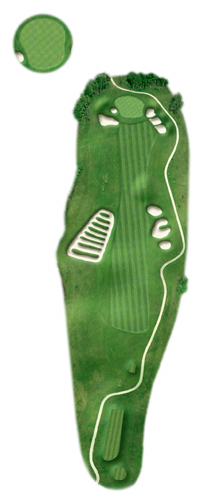 Historical Significance
Historical SignificanceOakmont Country Club in Pennsylvania is the site of more major championships than any other U.S. course. Opened in 1904, Oakmont was intended to be the hardest course in the world, with fast, severe greens and over 200 bunkers, none more famous than the “Church Pews” that guard the 3rd and 4th holes.
In 1922, Gene Sarazen’s victory at Oakmont made him the first to win the U.S. Open and the PGA in the same year. Jack Nicklaus defeated Arnold Palmer in a playoff for his first professional victory in the 1962 Open. In 1973, Johnny Miller captured the U.S. Open with a final round 63 that ranks as one of the greatest competitive rounds of all time.
Renditions has not received permission to copy the selected hole and is not associated with, affiliated with or sponsored by the golf courses, champions, or championships listed here.
-
Hole #16 | Par 5 | HDCP 15
REPLICA OF SHINNECOCK HILLS #16
MAJOR CHAMPIONSHIPS HOSTED: U.S. OPEN – 1896, 1986, 1995, 2004, 2018Gold 542 • Blue 519 • White 464 • Red 406
 Historical Significance
Historical SignificanceShinnecock Hills in Southampton, New York was the first incorporated golf club in America, one of the founding clubs of the U.S.G.A. and host to the centennial championship. In the final round of the 1986 U.S. Open, nine players shared the lead. Raymond Floyd was not among them. Birdies at 11 and 13 put him into contention and, with the rest of the field faltering, he strode to the 16th with a one stroke lead.
Floyd's third shot was from 118 yards into the wind, a perfect 9-iron. But Floyd had left the 9-iron out of his bag, opting instead for a third wedge. Selecting his 8-iron, Floyd hit a punch shot that almost went into the cup. The key birdie sealed his fourth Grand Slam title and his only U.S. Open victory.
Renditions has not received permission to copy the selected hole and is not associated with, affiliated with or sponsored by the golf courses, champions, or championships listed here.
-
Hole #17 | Par 3 | HDCP 9
REPLICA OF WINGED FOOT (WEST) #7
MAJOR CHAMPIONSHIPS HOSTED: U.S. OPEN – 1929, 1959, 1974, 1984, 2006 • PGA – 1997Gold 166 • Blue 159 • White 135 • Red 126
 Historical Significance
Historical SignificanceDesigned by A.W. Tillinghast, Winged Foot Golf Club in Mamaroneck, New York is one of the crown jewels of golf in the United States. Champions at Winged Foot include Bobby Jones, Billy Casper, Hale Irwin, Fuzzy Zoeller and Davis Love, who broke through with his victory in the 1997 PGA. The bunkering is severe throughout the course, but especially so on the par 3s, which were Tillinghast’s trademarks.
In the 1974 U.S. Open, defending champion Johnny Miller sailed his tee shot at the 7th into the deep greenside bunker to the right of the green and took four shots to get out, ultimately taking a seven and dashing his hopes of defending his title.
Renditions has not received permission to copy the selected hole and is not associated with, affiliated with or sponsored by the golf courses, champions, or championships listed here.
-
Hole #18 | Par 4 | HDCP 7
REPLICA OF CHERRY HILLS #16
MAJOR CHAMPIONSHIPS HOSTED: U.S. OPEN– 1938, ’60, ’78 • PGA – 1941, ’85Gold 399 • Blue 388 • White 376 • Red 359
 Historical Significance
Historical SignificanceThe 1960 U.S. Open at Cherry Hills Country Club in Denver was perhaps the greatest of the 20th century. Arnold Palmer was the reigning Masters champion and pre-tournament favorite. Forty-eight year old Ben Hogan was paired with 20 year old Jack Nicklaus in the final round.
Palmer began that round seven strokes back but drove the first green, birdied six of the first seven holes and shot 65 to beat Nicklaus by one. Afterwards Palmer spoke with Bob Drum of the Pittsburgh Press about winning the Masters, U.S. Open, British Open and PGA in the same year. Though Palmer finished one back at St. Andrews, the concept of the modern Grand Slam was born.
Renditions has not received permission to copy the selected hole and is not associated with, affiliated with or sponsored by the golf courses, champions, or championships listed here.








